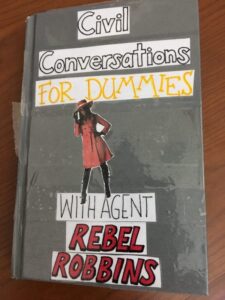Summary:
Molly Robbins of the Denver Writing Project offers students a road map to have hard conversations with people with whom they fundamentally disagree. After working on civil conversations and participating in the 3D Digital Democratic Dialogue Project, some of her students of color were empowered to speak at a professional development day for teachers, creating a powerful experience that shifted the conversation toward creating a more generative space where students feel included in their education.
The Civil Conversations Project (adapted from Krista Tippett’s work) offers students a road map to have hard conversations with people with whom they fundamentally disagree—a skill that is rarely modeled for them in today’s world. In the Civil Conversations Project, the point is not to debate, not to pontificate, not even to push a position forward. Rather, the point is to listen and ask questions to understand how the worldview of the opponent helped them form their views and opinions. In this way, students might move towards compassion in their conversations when they find disagreement.
Drawing from Tippett’s work, I had my students conduct these civil conversations with families and friends over Thanksgiving weekend—and they filmed them.
At this time, I was also participating in the Digital, Democratic, Dialogue Project led by Nicole Mirra. Through this project, three of my students of color participated in our district affinity groups where students of color from across my district talk together about their school experiences. The three students spoke at a new teacher induction meeting to share how new teachers can work to create excellent learning for each student who crosses their paths and to offer a more inclusive approach to teaching and learning.
As a result, I saw that my students felt empowered to begin discussing WHAT IF…scenarios with me:
- What if we do something like this at our school?
- What if I can share what school is like for me in order to create change?
- What would it look like for me to become an advocate for more inclusive practices at my school?
Every February my school has a professional development day marked on the calendar. On this particular February professional day, ten of our students of color came in to sit in a circle with our staff surrounding them and supporting them to discuss their experiences help our staff understand their worldview and how certain practices in the classroom help or hinder their learning.

Listening to our students and hearing their stories proved to be one of the most powerful professional development experiences as reported by most of our teachers. After the students spoke, teachers were put into small groups with a trained facilitator to debrief what they learned from the experience.
It was this move to have teachers hold dialogue with one another that created a new space for conversation in my school. This practice of learning how to listen and then come together to discuss learning has moved the conversation in my school from “those kids” toward “our kids.”
Having hard conversations requires a framework and a clear goal going into it. People must understand the ground rules before starting, and those ground rules must be supportive of understanding one another and creating a generative space.
If we can move competition in our teaching practices towards a collective commitment to understanding our children’s experiences, we can create more generative schools. Holding deep conversation with a commitment to understanding our students’ experiences while withholding judgment is one tool to create generative spaces where students feel included in their education. Krista Tippett is right—the first step is listening.


